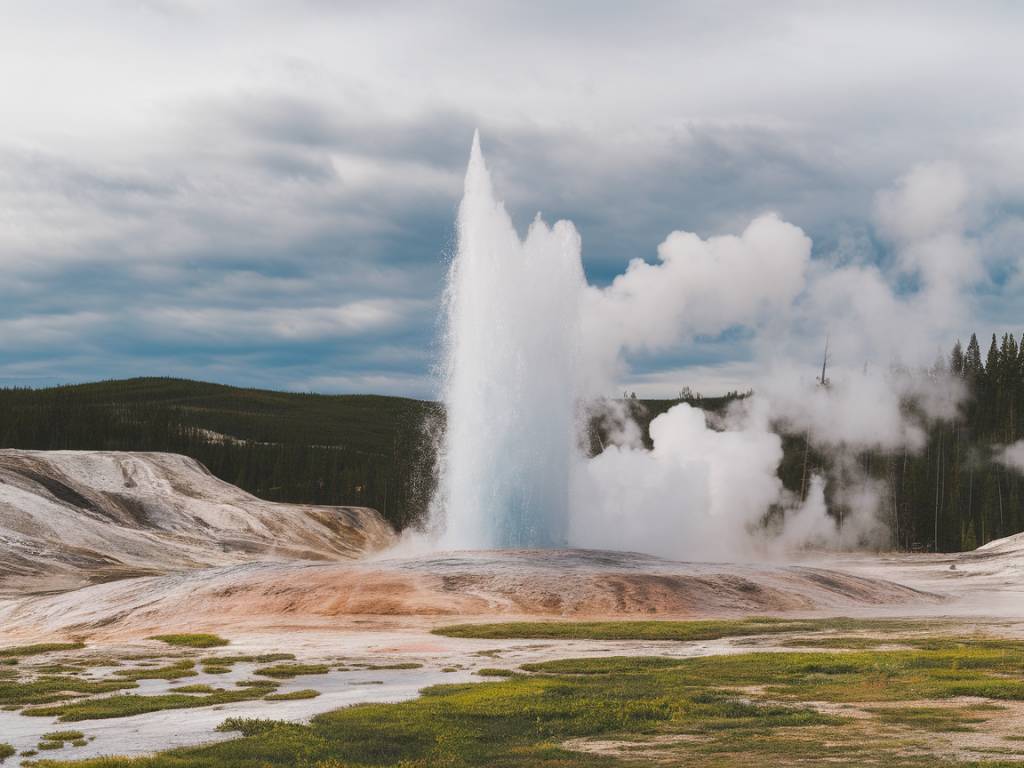Yellowstone National Park is renowned for its geothermal features, and among them, the Steamboat Geyser located in the Norris Geyser Basin stands as one of the most fascinating natural wonders. As the tallest active geyser in the world, Steamboat can launch water as high as 300 feet into the air. This impressive feat, coupled with its unpredictable eruption schedule, makes it a must-visit attraction for any park visitor. In this article, we’ll dive into the various aspects that make Steamboat Geyser a marvel of nature, including its geology, eruption patterns, and the best times to witness its grandeur.
Understanding the Norris Geyser Basin
Norris Geyser Basin is the hottest and most dynamic geyser basin in Yellowstone. It offers a unique landscape filled with thermal features that range from geysers to hot springs, fumaroles, and mud pots. This diversity makes Norris an ideal location for those looking to delve deeper into geothermal phenomena. The Silica-rich water found here contributes to the unique mineral formations, casting an almost otherworldly aura across the basin.
Geology of Steamboat Geyser
Steamboat Geyser is part of the Norris Geyser Basin and functions as a steam and water jet geyser. The geyser’s subterranean plumbing system is exceptionally complex, consisting of interconnected passages filled with hot water and steam. During an eruption, pressure builds up, forcing steam and boiling water through the geyser’s vent. This results in the dramatic water column that can reach as high as 300 feet.
The heat source for Steamboat and other geysers in the vicinity is the Yellowstone Caldera. This massive volcanic feature generates intense geothermal activity, which in turn fuels the geyser’s eruptions. The temperature of the underground water reservoir can reach up to 450°F, further contributing to the explosive nature of Steamboat’s eruptions.
Eruption Patterns and Frequency
One of the most captivating aspects of Steamboat Geyser is its unpredictable eruption schedule. Unlike Old Faithful, whose eruptions can be predicted with remarkable accuracy, Steamboat’s intervals between major eruptions can range from a few days to several decades. Historically, the geyser had been dormant for extended periods, but recent years have seen more frequent activity.
When Steamboat does erupt, it is nothing short of spectacular. The water phase lasts anywhere from 3 to 40 minutes, followed by the steam phase, which can continue for hours. This prolonged duration allows visitors ample time to experience the eruption in its entirety. Interestingly, even the minor eruptions are a sight to behold, producing smaller but still impressive displays of hot water and steam.
Best Times to Visit
Given its unpredictability, it’s challenging to pinpoint the best time to visit Steamboat Geyser specifically. However, tourists can increase their chances of witnessing an eruption by visiting during peak geothermal activity seasons, generally from late spring to early autumn. Summer months bring more tourists, but they also coincide with heightened geothermal activity, potentially increasing the likelihood of an eruption.
For those looking for a quieter experience, visiting during the off-peak seasons like early spring or late autumn can be rewarding. The Norris Geyser Basin is less crowded during these times, allowing for a more intimate exploration of the area’s geothermal features.
What to Bring and Safety Precautions
When visiting Steamboat Geyser and the Norris Geyser Basin, preparation is key. Here are some essential items to bring:
- Comfortable walking shoes: The basin’s trails can be uneven and slippery, so good footwear is critical.
- Water and snacks: There are no amenities within the basin itself, so come prepared.
- Layered clothing: Yellowstone’s weather can change rapidly, especially in areas of high elevation.
- Camera or smartphone: Capturing the grandeur of Steamboat Geyser is a must.
While the temptation to get close to these geothermal wonders is strong, safety cannot be overstated:
- Stay on designated boardwalks and trails to protect both yourself and the delicate geothermal environment.
- Heed all warning signs and guidelines issued by park rangers.
- Be cautious of the hot steam and boiling water that can be ejected during an eruption.
Scientific Significance and Research
Steamboat Geyser also holds immense scientific significance. Geologists and volcanologists closely monitor its activity to gain insights into the geothermal processes occurring beneath Yellowstone. The data collected from Steamboat’s eruptions, including temperature measurements, water chemistry, and seismic activity, contributes to a broader understanding of geothermal dynamics and volcanic behavior.
Recent advancements in monitoring technology, such as real-time data analytics, have provided scientists with unprecedented insights into the mechanics driving Steamboat’s eruptions. This information not only enhances our understanding of this specific geyser but also informs broader geological theories and models.
Nearby Attractions
While Steamboat Geyser is undeniably a highlight, the Norris Geyser Basin itself is home to a plethora of other fascinating geothermal features. Some nearby attractions include:
- Porcelain Basin: Known for its milky blue thermal pools and colorful mineral deposits.
- Back Basin: Offers a more forested setting with several active geysers and hot springs.
- Echinus Geyser: Once one of the largest acid-water geysers in the world, it still displays occasional eruptions.
Exploring these areas will offer a more comprehensive understanding of Yellowstone’s geothermal activity and provide additional opportunities for awe-inspiring experiences.
Personal Reflections and Recommendations
Having had the privilege to guide numerous tours through Yellowstone, I can attest that witnessing an eruption of Steamboat Geyser is a rare and exhilarating experience. The sheer power and scale of the eruption are genuinely humbling, leaving visitors with a newfound appreciation for the Earth’s geothermal marvels.
If you’re planning a visit to Yellowstone, I highly recommend allocating ample time to explore the Norris Geyser Basin. While Steamboat Geyser is the crown jewel, the entire basin offers a rich tapestry of geological wonders waiting to be discovered. Make sure to pack the essentials, respect the natural environment, and keep your camera ready for what might be a once-in-a-lifetime spectacle.
